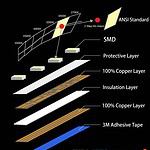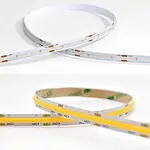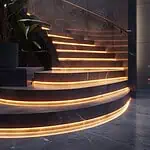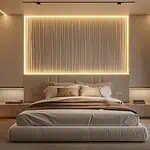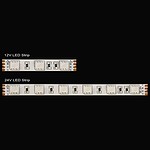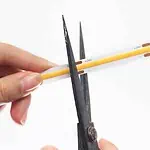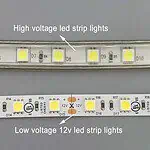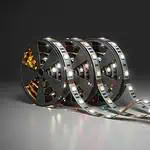Want to bring a sleek and modern ambiance to your bedroom? Go for bed lighting. But how to add LED lights to a bed?
The best choice is to transform the bed with LED strips. You can place them beneath the bed, behind the bed headboard, or go for any creative ideas. The impressive fact is that the LED strip lights come with some advanced features like- CCT adjustability, color customization, dimming feature, and more. All you need to do is choose the right variant for your bed. However, the amber or red color LED strip lights are the best for attaching to a bed. Not only does this colored LED Strips light provide a calming, pleasant color effect that promotes peace of mind, but it is also proven to improve your sleep quality.
Besides learning how to add LED lights to your bed, you should also know what light is best for bed lighting. No worries, I have added all the information you require for this. So, without any further delay, let’s jump deep into bed lighting with LED light:
What Type Of LED Light Is Best For Bed?
Warm LED lights with low CCT are best for bed. They give off a soft yellow tone that brings a cozy vibe. It is scientifically proven that warm lights are good for sleep. Red, orange, yellow, and amber are the colors that stimulate melatonin production in your body. So, you feel relaxed and can have a good sleep at night. Red LED light is considered the best option here; it has a lower color temperature than the sun and is best as a sleep light. Besides, you also need to watch out for the brightness of the light. If the fixture is too bright and has a glaring effect, it is not suitable for bed. In this case, indirect bed lighting with LED strips works best. You can choose dim-to-warm LED strip lights that allow you to adjust the CCT of warm light colors. For the best ideal LED light for your bedroom, check this- Dim To Warm – What It Is and How Does It Work?
How to Add LED Strip Lights to a Bed? – A Stepwise Guide
Although setting LED strip lights on your bed may seem difficult at first glance, you can easily do it on your own. I’ve organized everything perfectly below for your convenience.
Step 1: Gather Required Materials
Besides LED strip lights, there are some more things you will need to do for the installation. These are what you need-
- LED Strip lights
- An LED dimmer controller( a device used to regulate your LED strip lights)
- A power source
- Switch
- Two crocodile tests lead to checking the circuit
- Tape measure
- Pliers
- Wire stripper
- Extra cable and wires (just in case)
Step 2: Check The LEDs and the Power Source
Next, you should check the power supply, as it is essential to avoid overloading the LEDs, which could cause a circuit cutout. For this, you need to ensure the voltage of the LED strip lights matches that of the power source. LED strips are voltage-sensitive. If you install a 24V LED strip to a 12V power source, it will not glow as brightly as expected. Besides, the voltage drop is also a fact to consider. Again, placing a low-voltage strip to a high-voltage power source will overpower and damage the fixture. Therefore, testing the LED strips early on is an intelligent move before you find out that all your effort was pointless and the LED strip lights are broken. For better guidance on LED strip voltage, check this- Low Voltage Vs. High Voltage LED Strips: When to Choose and Why?
Step 3: Measure & Cut Strips
Most of the LED strip lights come with strong adhesive backing. And you will notice after a few inches there is a cut mark on the solder pads of the LED strip lights. These cut marks are provided so you can cut the strip lights according to your needs. First, take the measurement of the length and width of the bed. Now, cut the strips according to that measurement. This guide will help you cut the strips correctly: Can You Cut LED Strip Lights and How To Connect: Full Guide.
Step 4: Combine And Assemble The Strip Lights
Once you have cut the strips, join the length and width strips that will go beneath the bed or any other area where you want to install them. You can use LED strip connectors or soldering to join the strips. Besides connecting the pieces of strips, you should also assume the full circuit at this stage and check if they work. Connect the controller and driver to the circuit. In the entire process, ensure the device’s positive end is connected to the positive end of the LED strip, and the negative end is connected to the negative end. Thus, connect all the strips, controllers, and drivers and see if they glow. After ensuring the circuit is proper and works, move to the next step.
Step 5: Attaching the LED Strips to the Bed
Now, you need to simply install the LED strip set to the bed that you have already arranged. As LED strips come with adhesive backing, you can just peel off the tape and press it on the bedsides where you want them to be installed. If you are not satisfied with the robustness of the adhesive backing, you can also go for clips. But this will require drilling, which will lead to making holes in your bed. So, I will prevent you from going for the clipping system. Yet, the choice is yours; read this to learn more about the LED strip mounting techniques- Installing LED Flex Strips: Mounting Techniques.
Step 6: Light It Up!
After completing the installation, turn on the switch and check if it glows. In case the strip doesn’t glow, check the connection and power source to look for any issues. Fix them up, and you are done! Clean up the mess, tidy up your bed, and enjoy your bed lighting.
Consideration For Choosing The Best LED Strip Lights For Bed
Before choosing the strip lighting for your bed, ensure the fixture you choose is ideal for your bed. Here are some facts to consider-
Color Temperature
When it comes to bed light color, the most important fact to consider is coziness. A soft color light will keep you relaxed in bed and aid in good sleep. For this, warm colors with low CCT work best. You can use these strips to create indirect bed lighting. Turning them on at night will simulate the melatonin production and help you sleep well. For better rest, keep the color temperature of your bedroom light between – 2200K and 2700K. But if you want a warmer tone, going for 1800K is also ok. In this case, I suggest you try our dim-to-warm LED strips. They allow you to adjust the CCT from 3000K to 1800K. So you can get the desired warm tone for your room. However, RGB LED strips are also a popular choice for bed lighting. They can bring up to 16 millions of hues! So, if you want more control over your bedroom lighting, RGB LED strips are an excellent choice. However, choosing the right color is essential as color greatly influences your mood. To learn more about this, check this- How To Use LED Light Colors For Different Moods?
Controller
Do you find it annoying to get out of bed whenever you want to turn the light on or off or adjust the brightness? And there’s an answer to that. Nowadays, the majority of us select LED strip lights since they include controllers. This allows you to stay seated and adjust the light’s settings according to your needs. LED Strips have different types of controllers. These include-
- IR LED Controller
- RF LED Controller
- Wi-Fi LED Controller
- Bluetooth LED Controller
- 0/1-10V LED Controller
- DMX LED Controller
Using a remote, you can easily control the LED strip light and customize the light color. Many LED strips also allow smartphone control and voice assistance and can also sync to music. All you need to do is find the ideal LED controller for your LED strip. To learn more, check this- LED Controller: A Comprehensive Guide.
Brightness & Dimmable
Always avoid too bright lights in your bedroom. A high-lumen bulb can be irritating while sleeping. However, it’s not like you only use your bed for sleeping; there are many tasks you may need to do in the bedroom that require bright light. For instance, you will require bright light when reading books, but this light is not ideal for sleeping. And that is why you go for dimmable LED lights. This allows you to adjust the brightness of the room as per your requirements. So, when you are doing any task in the bed, increase the brightness and dim it when sleeping. Nevertheless, a lumen rating ranging from 400-800 lumens is ideal for bedrooms, depending on their size. But with dimmable features, you can get the one you feel comfortable with.
Voltage
Usually, LED strip lights run at low voltage. Though high-voltage LED strips are also available, low-voltage ones are ideal for indoor uses. If your power source is 24V, you will need to purchase an LED fixture with the same voltage. If you use a 12V LED strip here, it won’t work well. The extra voltage running through the strip will overpower it and damage the LEDs. Again, if you join too many LED strips together, there are chances of voltage drop as you increase the length. In this case, you will have to go through additional wiring to keep the voltage flow smooth. To learn about this, check this article- LED Strip Light Internal Schematic and Voltage Information.
Cutting Mark Length
The cutting mark lengths of high and low-voltage LED strip lights are different. If you select high-voltage LED strips with a 110V–240V range, the cut length will be 10 cm, 50 cm, or 100 cm. On the other hand, compared to high-voltage LED strip lights, low-voltage LED strip lights have more frequent cut marks. And their typical distance apart is between 5 and 10 cm. Additionally, the small space between cuts on these LED strip lights increases their flexibility for precise size, cutting, and other creative projects you may have in mind. You might be wondering, at this point, where to cut the strip lights. All kinds of LED strip lights have a scissor mark at a specific distance, indicating where to cut it. So you must cut it precisely at the spot of the cut mark. The LED strip lights will stop working if you simply cut somewhere else.
LED Density
The density of the LED strip matters a lot when considering the visual output of the lighting. LED density means the number of LED chips per meter running through the PCB. The low-density LED strip creates hotspots. As a result, you won’t get that finished look from the fixture as you install them on the bed. It can also create glaring issues. To get rid of such an effect, you will need LED diffusers, which require extra steps. To avoid this, going for a high-density LED strip is the best option. You will get even lighting that enriches the outlook of your bed area.
SMD & Width
SMD is also a crucial factor to consider in the light output, though it is often neglected. SMD numbers indicated the size of the LED chip used in the fixture. LED strips are available in different chip sizes. Of them, the most popular sizes are 2835, 3528, and 5050. Besides, other chip sizes are also available. The difference in SMD brings variation in the lighting effect. So, you need to consider this factor too. For details, check this- Numbers and LEDs: What Do 2835, 3528, and 5050 Mean? However, the PCB where the LED chips are arranged comes in different widths. When lighting your bed, you may want to go for narrow strips. However, for more prominent effects, wider ones are also ok. LED strips are available in single and multiple rows. The single-row LED strips have widths ranging from 1mm to 15mm. Meanwhile, the multiple-row ones can be as wide as 120mm. So, decide how thick strips you need and then purchase accordingly. This guide will help you with LED strip widths- What LED Strip Widths Are Available?
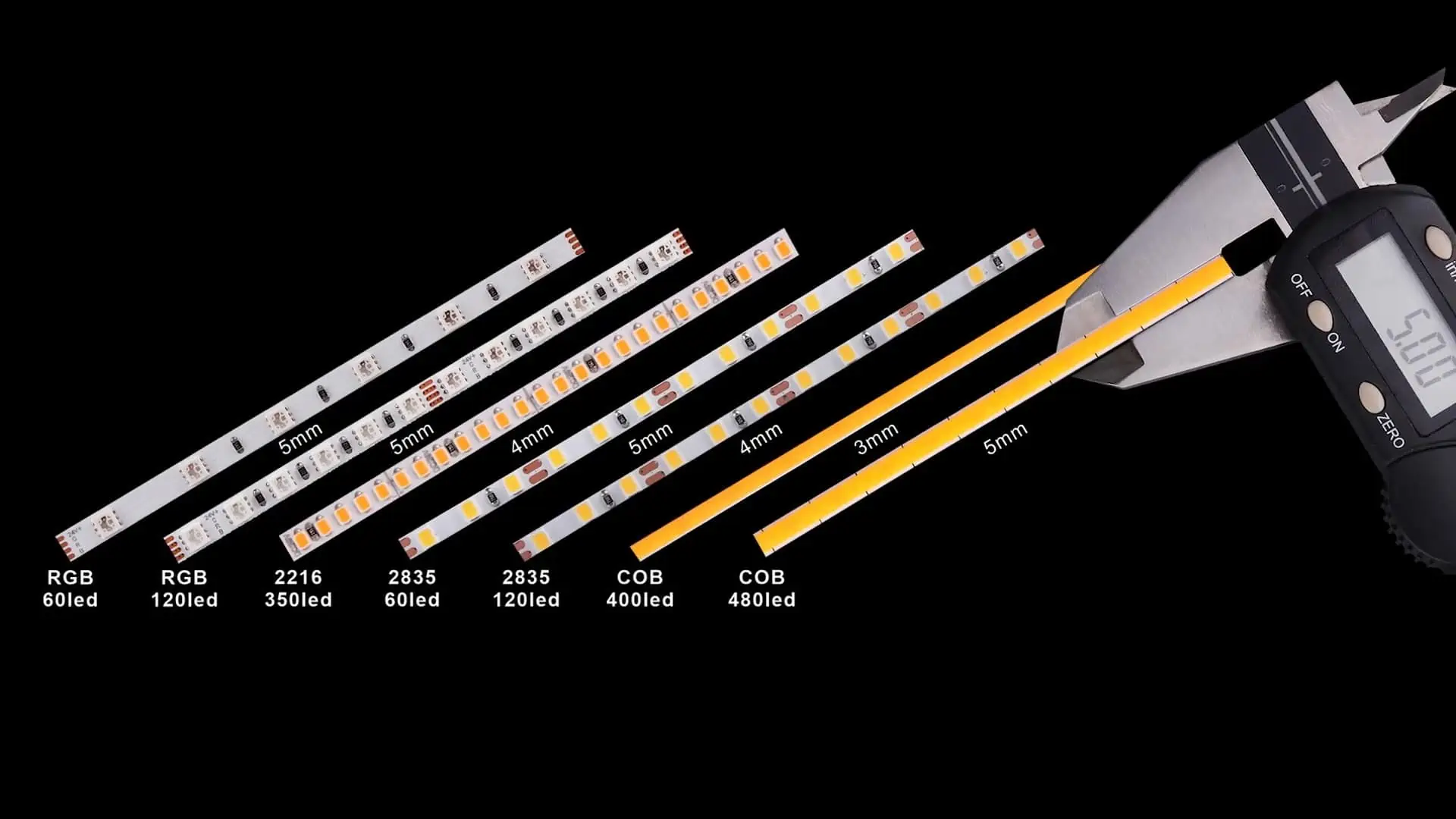
How To Choose The LED Light According To The Bed Size?
If you are new to LED strip lights, purchasing a whole kit may seem simpler and more affordable. But will the packaged set fit the size of your bed? A single bed has a certain length that differs from a king-size bed. Read below to figure out which size of bed you are considering buying an LED strip light for:
a. King-Size Bed
Even if there is not much of a size difference between a king and a queen bed, you can never expect an LED strip light of the same length to fit a queen- or king-size bed because the two beds’ widths are different in size. The queen-size beds are usually 60 inches (5 feet) in width by 80 inches (6 feet, 8 inches) in length. You will need about a 12 feet LED strip to cover a queen-size bed. As the king-size bed, one standard-size LED strip reel of 5 meters/16 feet will work well for a queen-size bed. Besides, you will have much more leftovers that you can use for other projects.
b. Queen-Size Bed
Even if there is not much of a size difference between a king and a queen bed, you can never expect an LED strip light of the same length to fit a queen- or king-size bed because the two beds’ widths are different in size. The queen-size beds are usually 60 inches (5 feet) in width by 80 inches (6 feet, 8 inches) in length. You will need about a 12 feet LED strip to cover a queen-size bed. And as the king-size bed, one standard-size LED strip reel of 5 meters/16 feet will work well for a queen-size bed. Besides, you will have much more leftovers that you can use for other projects.
c. Twin Bed Size
Twin beds are smaller and mostly designed for a single person. Therefore, choosing an LED strip light for a twin-size bed is easier than a king- or queen-size bed. Assuming the twin-size bed’s LED strip lights are at least 25 to 30 inches long. This length is sufficient to enclose the bed entirely. In case you’re wondering about the brightness of the LED strip lights, 400 watts will be enough to light up the area surrounding the bed and the room. You can roam around the room, read, work on any project, or just unwind by taking a nap with this amount of light.
5 Bed Lighting Ideas With LED Strip
Installing LED strip lights is a simple, affordable option to light up your bed. These fixtures give your bedroom a unique and cozy atmosphere. You can creatively use them anywhere in the bed. It could be beneath the bed, behind the headboard, or on the back wall of the bed. Below, I’m sharing with you the top five impressive ideas for LED strip bed lighting:
1. Add LED Strips Under The Bed
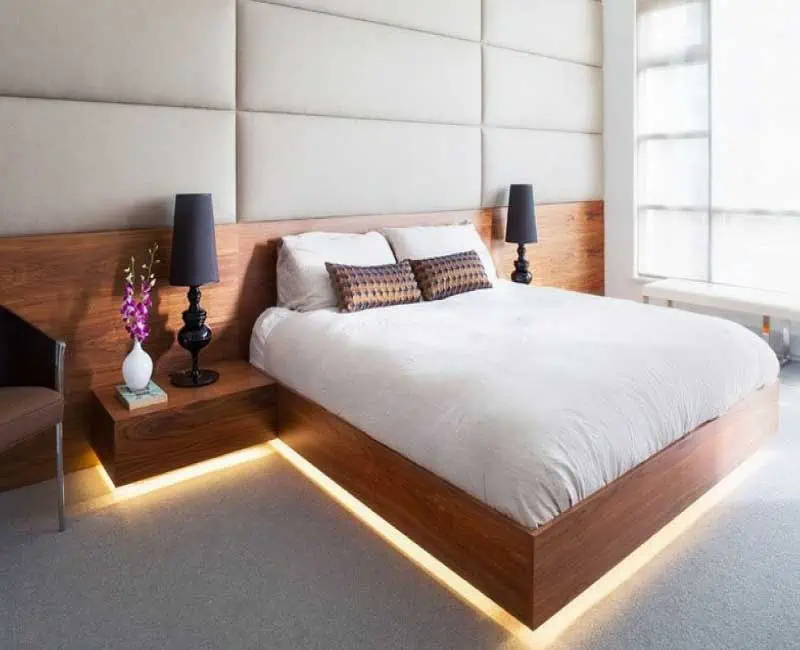
Adding LED strip lights underneath the bed can be amazing, mainly if they are addressable LED strips or RGB LEDs. These fixtures can simultaneously produce various colors, creating an ombre effect. Combined colors produce a more spectacular multicolored display with a soft, calm glow. And ‘Under glow lighting’ is the standard word to describe this kind of lighting. You will see a beautiful glow under the bed, the perfect place to install the LED Strip lights. These lights typically have a remote controller, sometimes a phone app, to control them. Making the process of managing the lights to change their color and design more effortless for you. It’s really simple to add LED strip lights underneath the bed. To get started, measure the space where you want the LED strip lights installed. Then, get the LED strip lights. Connect the LED strip lights with the help of a power supply and a controller. For the controller to receive the infrared signal from the remote, mount it somewhere visible. Turn it on and enjoy.
2. Light Up The Headboard
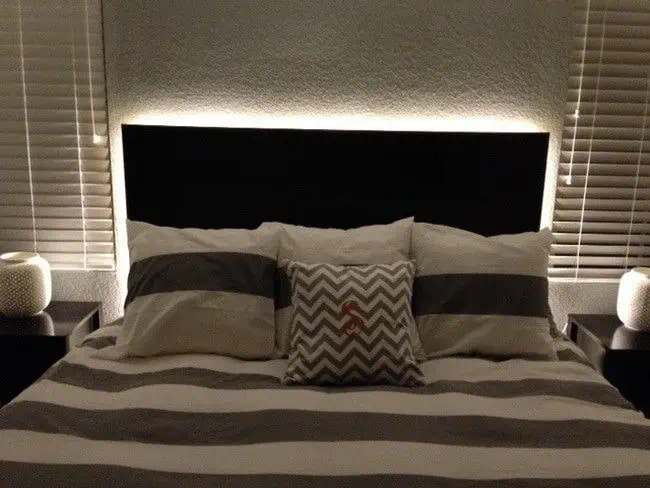
An excellent method to improve the appearance of your bed is to attach LED strip lights to the headboard. Implementing this technique, you can create a floating effect; the bed’s back wall appears floating. Additionally, it will give the bed’s wall a dispersed color. You can always select the LED strip lights based on the kind of bed. The white LED strips will have an elegant, enduring appearance. On the other hand, the cozy and serene vibe will be created by the warm LED colors. Besides, the RGB LED strip lights will create a vibrant, trendy atmosphere. In this case, I suggest you consider the material of the bed. If the headboard is made of wood, warm lighting will suit best. But if you have something colorful, consider the color tone. You can also go for tunable white LED strips. These fixtures allow you to adjust the CCT from cool to warm tone. That is, when you are reading books sitting in bed, use cool white light, and while relaxing, choose a warm tone light. This will bring vibrance to your room and also increase functionality.
3. Create a Floating Effect
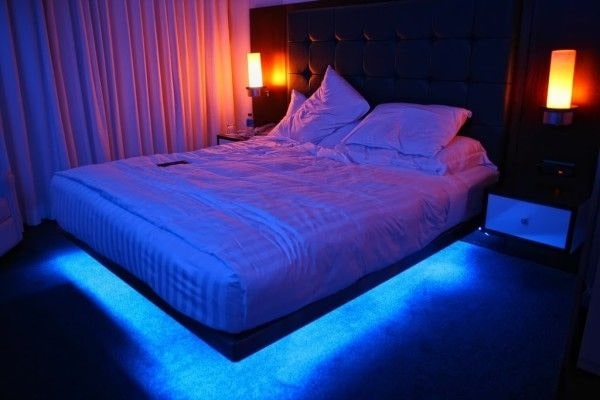
Want to bring a magical effect to your bed area? Go for the floating lighting technique with an LED strip. For this, you will have to install the strips beneath the bed, creating a hidden effect. To create this effect, you need to install LED strips around the edges beneath the bed, keeping at least 2 to 3 inches from the boundary line. This will create an illusion of zero gravity. However, to implement this idea, you must have a bed that has sufficient space underneath. Besides, a blue light will work best with the floating theme for the best effect. Now you may wonder, is blue the ideal choice for bedlighting as it is not the best pick as a sleep light? As you are using the fixture under the bed, this will not hamper your sleep cycle. Instead, create a calm atmosphere. Yet, you should choose low-lumen fixtures to keep the coziness. You can further add warm-tone light fixtures around the bed to keep the relaxing ambiance of the bedroom intact. For instance, the bed lamps, just as in the above picture, are an excellent idea to go for. To learn more bedroom lighting ideas, check this- 35 LED Strip Ideas for the Bedroom.
4. Add RGB LED Strips For A Magical Bed
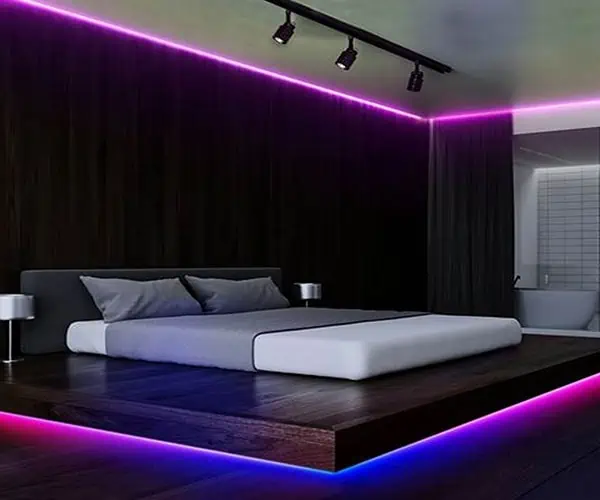
Do you know that by using RGB LED strips, you can produce about 16 million different light colors for your bedroom? If you want more control over your bed lighting, RGB LED strips are the best option to use. These fixtures come with a remote control where you will get light color customization features. Mixing different light colors can bring the illumination you want. For instance, by mixing red and green light, you can create a yellow hue. Thus, RGB strip lights allow you to adjust the lighting’s color to suit your mood and create a calming ambiance. However, RGB LED strip lights have different variants that you should know. They can be RGBW, which comes with an additional white chip; RGBIC, which features an advanced IC (Independent Control) chip; and other variants are also available. Do you find this interesting? Check this to learn more- RGB vs. RGBW vs. RGBIC vs. RGBWW vs. RGBCCT LED Strip Lights.
5. Light Up The Back Wall Of The Bed
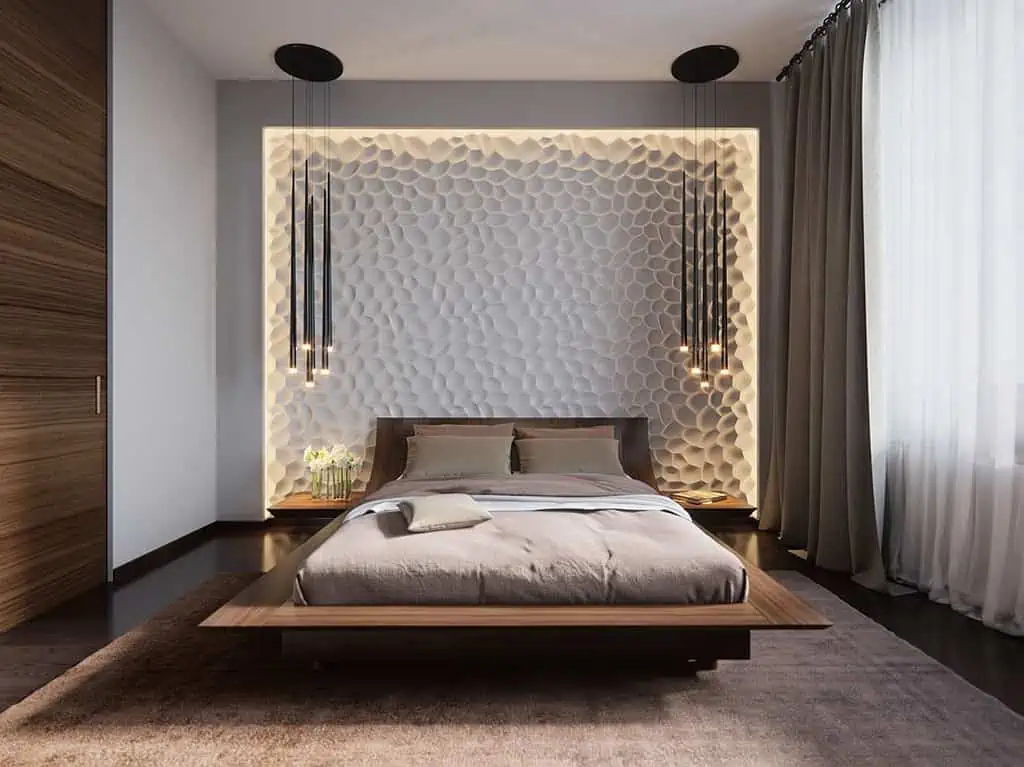
Usually, accent wall lighting is installed to highlight a specific wall area. This kind of lighting works best if you have a textured wall behind your bed’s headboard. You can use LED strips creatively in this space. For instance, create a false framing for the wall and hide the LED strips around the frame’s edges, just as in the above picture. This will create an indirect and soft illumination for your bed. Besides you can also use the strips to form geometrical figures to create a statement look. The door for DIY is wide open; you can implement any design. However, for the back of the bed, neon quotes are pretty popular. You can use LED neon flex to add any signage or quotes on the back wall of your bed. Check this article for more ideas- Top 26 Creative Neon Sign Lighting Ideas.
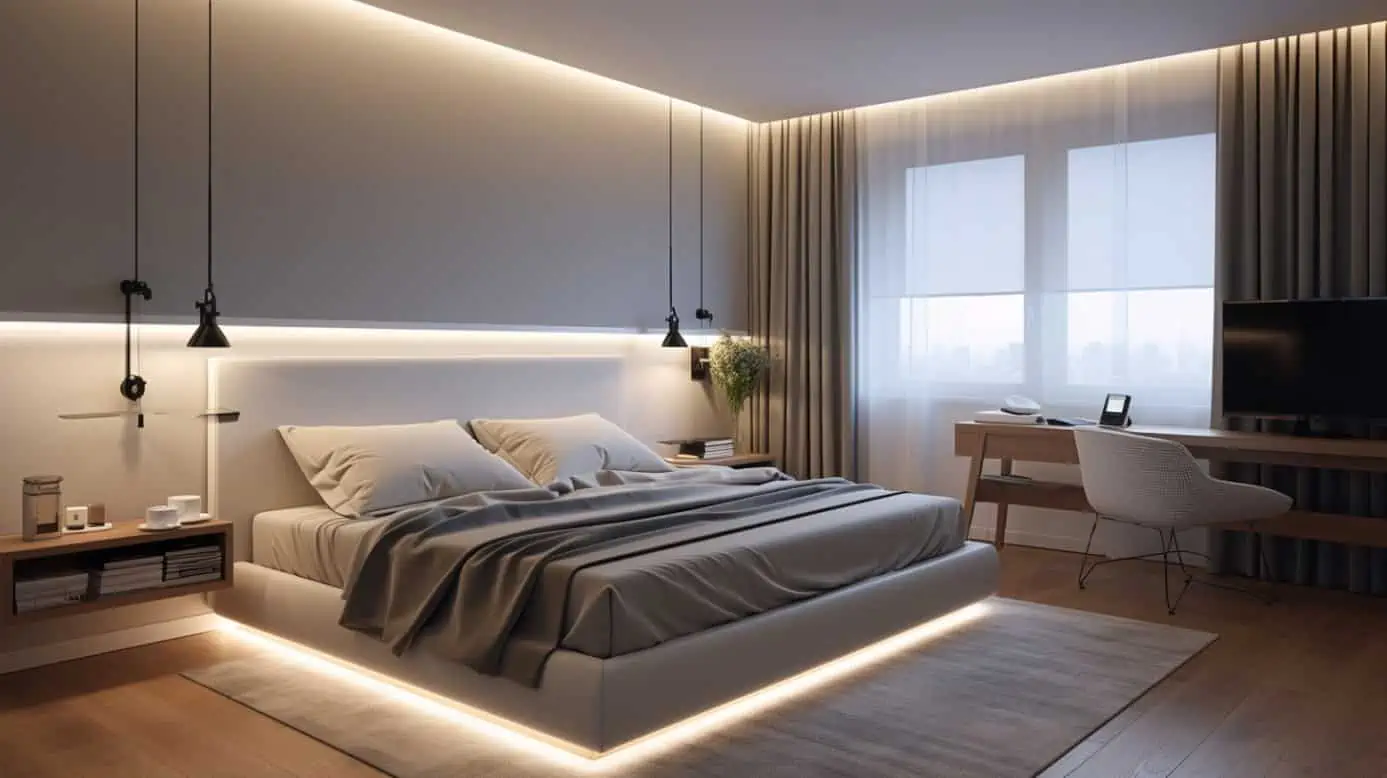
FAQs
Yes, you can install LED strip lights on your headboard. LED strips run at a low voltage and produce minimal temperature. So, installing them on your bed headboard will not burn the bed or cause fire breakout risks. Besides, as they are super flexible, you can bend, resize, and put them around the edges to fit the headboard.
LED lights operate at lower temperatures and don’t get overheated like traditional fixtures. This is what makes them safe to use behind the bed. As long as you choose high-quality brands of LED strip lights, there is nothing to worry about. However, you should always consult an expert before placing them in a location like your bed if you choose a less expensive brand or from a website that isn’t very reliable. It’s essential for your safety because you will be sleeping there.
There are several spots on the bed to install your LED strip lights. For example, you can attach the LED strip lights to your bed’s headboard, underneath it, or along its edge. This will make your boring bed look fun. Additionally, these LED strip lights include adhesive. Take out the sticky paper, choose a corner of the bed, and set it there- pretty simple to install.
LED or strip lights will eventually heat up, no matter how expensive they are. However, LED strip lights are far safer and better manufactured than lighting from older times. Therefore, there’s no need to worry. Compared to other LED lights, the heat from the LED strip lights is not a significant issue.
According to studies, red and amber LED strip lights are suitable for bedroom use. Red or near-red colors are considered best for sleeping. They have lower color temperature and promote deeper sleep at night. These light colors help stimulate melatonin production, promoting better sleep.
You can install LED strip lights anywhere in the room, depending on your preference. For instance, you can put them beneath the bed, under cabinets, behind computers and TV screens, beneath shelves holding art collections, mirrors, stairs, and in almost any location you can imagine.
The Bottom Line
When adding LED lights to your bed, always choose minimal fixtures that can get well into your bed. And for this, LED strips are the ideal choice. You can easily cut and install them anywhere in your bed by peeling off the adhesive backing. This makes light installation much easier. You don’t even need any professional to add LED strip lights to your bed. However, the quality of the light matters here. And when it comes to premium quality, nothing can beat LEDYi. All our LED strip variants are well-binned and have a 3-5-year warranty. We have all categories of LED strips that fit your bed. Go for our dim-to-warm and tunable white LED strips for adjustable CCT for your bedroom. And if you want a colorful option, check out our RGB LED strip lights. Besides, if you are a DIY lover and wish to add neon signage or quotes on the back wall of your bed, we also have LED neon flex. So, why wait anymore? Place your order ASAP!
